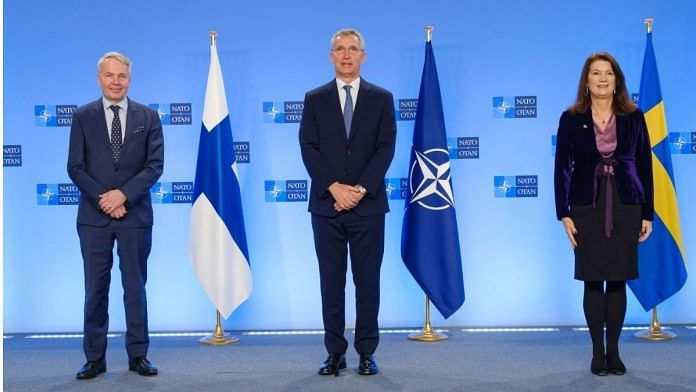One of the ironies of Russia’s war against Ukraine — ostensibly fought to prevent that nation from joining the North Atlantic Treaty Organization — has been its impact on two of Europe’s traditionally neutral states, Finland and Sweden. On May 18, just 84 days after the invasion, Swedish and Finnish ambassadors handed over applications to join NATO in a public ceremony at the alliance’s headquarters in Brussels.
“This is a historic moment which we must seize,” said Secretary-General Jens Stoltenberg. “You are our closest partners, and your membership in NATO will increase our shared security.” It seems likely that their applications will be swiftly approved, and NATO will soon grow to a 32 member states.
Yet in the rush to give Putin a black eye by embracing Finland and Sweden, US and NATO leaders may be failing to consider the potential costs of inducting two more countries into what, after all, is intended to be a collective defense organization.
There are only two clear-cut benefits to bringing in the two Nordic nations. The first is symbolic: providing a clear demonstration of European and democratic solidarity against Russian aggression in Eastern Europe. The second is technical: Admitting Finland and Sweden would better align the membership of NATO with that of the EU, avoiding the unlikely but problematic scenario in which an EU member state is subject to aggression but is not covered by NATO’s Article 5 mutual-defense pact.
In every other respect, however, the question of Finnish and Swedish membership is more complicated and worrisome. Consider overall European defense capacity.
Yes, Finland and Sweden have highly advanced economies. They could be net contributors to NATO’s technological capabilities through national champions like Ericsson AB and Nokia Oyj. They are also more capable militarily than some other European states — particularly Finland, which has maintained conscription into the post-Cold War period and has a relatively wide range of military competencies, including the continent’s largest artillery force.
Yet from the point of view of existing NATO members — and particularly the US — it’s still not necessarily a net win. Finland and Sweden have long focused their militaries on defending their own territories, raising doubts about their value in contributing to a common defense, which is at the heart of NATO’s charter.
And while both nations have pledged to increase their military spending and ability to bolster Europe’s broader defenses, it is also possible that they would not. Instead, they may free-ride on America’s military strength — and its nuclear umbrella — as so many European states have done for years. According to the International Monetary Fund, neither country comes close to meeting the NATO goal of spending 2% of GDP on defense.
Also read: Europe dreams of military power, but NATO’s still in charge. India must engage with caution
History suggests the most likely outcome is two more states adding to America’s defense burden at a time when Washington should be pivoting to Asia.
Consider also the question of the defensibility of new NATO territory. Admitting Sweden could be strategically beneficial, allowing NATO forces to better control the Baltic Sea and to use Gotland Island, at an important chokepoint off the Baltic States, as a staging ground for any future conflict.
Finnish territory, in contrast, is a strategic nightmare. It would dramatically increase the alliance’s exposure to any future attacks by Moscow: the country shares an 800-mile border with Russia that, as a recent study from the Center for Strategic and International Studies put it, is “highly exposed to Russian military threats.”
There are grab bag of other reasons for caution, including the usual concerns about expanding the alliance to an ever-more unwieldy set of member states. It doesn’t take a genius to predict that 32 nations will be even harder to manage than 30. Before its Ukraine moment, NATO was struggling to maintain the peace between Greece and Turkey, few nations were meeting the 2% spending goal, and President Emmanuel Macron of France had drawn headlines for suggesting the alliance was experiencing “brain death.”
Even in the face of Russia’s aggression, support for adding the two members isn’t unanimous. Turkey’s vehement opposition to Finland and Sweden may be an attempt to wring political concessions from the alliance, but also owes a lot to these countries’ support for Kurdish causes.
Alliance leaders should also consider the risk of Russian overreaction. Moscow has started three wars over potential NATO expansion — invading Georgia in 2008 and Crimea in 2014 before the current war. While Moscow is clearly not able to stage another major military campaign right now, one cannot rule out President Vladimir Putin doing something irrational in response to a NATO expansion that takes the alliance within 200 miles of his birthplace of St. Petersburg.
At the same time, it’s not clear that Finland and Sweden are at increased risk unless they are allowed NATO membership. They have long relied on their neutral status and domestic defense capacity to prevent crises. Refusing to admit them to NATO is not hanging them out to dry, but simply retaining a workable status quo.
The symbolic value of admitting two new member states as the price for Russia’s brutality in Ukraine may carry the day in Brussels. But before proceeding further with the accession process — which offers leaders and legislatures in each member state a chance to weigh in — policy makers should consider the whole strategic picture, and whether admission strengthens the alliance or not.
Article 10 of the North Atlantic Treaty makes clear that existing members may invite new states to join if they “contribute to the security of the North Atlantic area.” By that standard, the strategic case for admitting Sweden and Finland to NATO is not a slam-dunk.—Bloomberg






